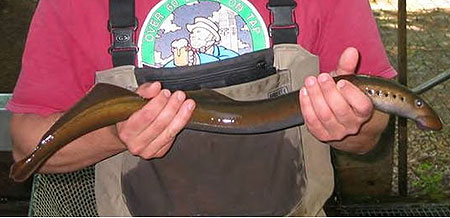Pacific Lamprey
(Entosphenus tridentatus)
Species Profile
Did You Know?
Adult Pacific lamprey can be distinguished from other species of lamprey by the presence of three large teeth and posterior teeth on the oral disc.
General Description
The Pacific lamprey is an eel-like fish up to 25 inches in total length. Pacific lampreys are distinguished from other Alaska lampreys by three large teeth on the supraoral bar and three sharp points on each of the central lateral tooth plates.
Adult Pacific lampreys are blue-black to greenish on the dorsal side and silver to white on the ventral side. Metamorphosis of Pacific lamprey from larval to juvenile life stage occurs gradually over time as juvenile lamprey develop eyes, teeth, and the ability to swim freely. During spawning, adult Pacific lamprey can appear to be reddish-brown in color.
Life History
Growth and Reproduction
Pacific lampreys are anadromous which means it spends part of its life in the ocean and part of its life in fresh water. Anadromous Pacific lampreys may spend months moving to the cool, clear headwaters of streams to make their nest or redds. Both males and females participate in redd building in stream riffles by removing small rocks with their mouths and fanning smaller particles with their tails. Males and females intertwine while simultaneously depositing sperm and eggs into the redd. Depending on her size, a single female can release up to 100,000 eggs. The adults die soon after spawning. The eggs hatch in freshwater in 2 to 4 weeks depending on the water temperature. Larval forms of lampreys, referred to as ammocoetes, are born without eyes and lack sucking mouthparts. Lampreys remain at this stage for three to seven years before metamorphosing into juveniles, which includes the development of a sucking mouth, eyes, and teeth.
Feeding Ecology
Ammocoetes burrow into the silt, mud, or mud of shallow pools and eddies of clear streams and feed by filtering microorganisms, algae, and detritus from the water. Anadromous adult lampreys parasitize other organisms such as other species of fish or even marine mammals by using their sucking mouthparts to attach themselves to the host’s body. They then use their teeth to cut through the scales and skin to get to the host’s blood and body fluid.
Migration
Parasitic adult lampreys migrate to the sea after metamorphosing from juveniles and tend to spend one to four years in the marine environment before returning to freshwater to eventually spawn. Anadromous lampreys return to return to fresh water in the fall and overwinter until spring when they spawn. Lampreys tend to migrate upstream in large groups and once upstream migration commences, lampreys do not feed.
Range and Habitat
In Alaska, Pacific lampreys are found from Nome, Saint Mathew Island, the Wood River, Unalaska Island, Bristol Bay, Cook Inlet, the Copper and Gulkana rivers in Southcentral Alaska, and the Chilkat River in Southeastern Alaska.
Status, Trends, and Threats
Status
Population discreteness for Pacific lampreys within and among river systems in Alaska is unknown, as very little information exists on Pacific lampreys in general. It is clear that an understanding of Pacific lamprey genetic population structure is necessary to identify appropriate management units for maintenance of biodiversity and productivity.
Trends
Overall strength of Pacific lamprey returns varies across the state by year and location. Why run strength remains strong in some areas while weak in other areas is unclear.
Threats
Potential overharvest from commercial, personal use or subsistence fisheries is the main threat to the resource.
Fast Facts
-
Size
The Pacific lamprey is larger than other species of lamprey, measuring between 15 and 25 inches in length. -
Range/Distribution
From Nome, St Matthew Island, Wood River, Unalaska Island and southward to Canada. -
Diet: Juveniles are filter feeders of diatoms and algae from the sediment. Adults feed by attaching parasitically to various species of fish such as salmon or sharks or marine mammals such as sperm whales.
-
Predators
Variety of sharks, sea lions, and other marine mammals. -
Reproduction
Pacific lampreys are thought to overwinter and remain in freshwater environment for approximately one year before spawning. -
Remarks
Managed by the Alaska Department of Fish & Game in Alaska state water


